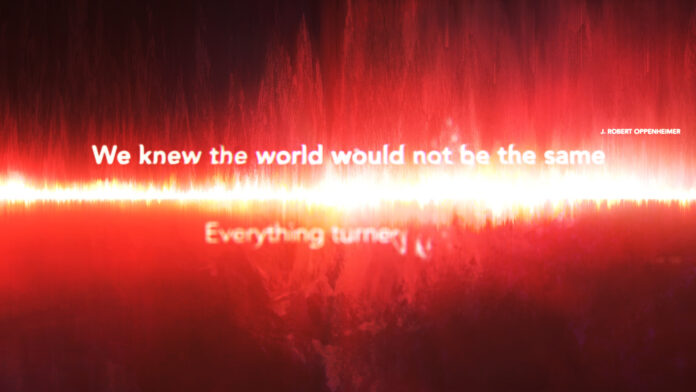75 years to the day since the dropping of the atomic bomb on the Japanese city of Hiroshima by allied forces during the Second World War, a new digital artwork from contemporary artist Es Devlin, working in collaboration with her long-term studio colleague Machiko Weston, was released this morning.
The artwork has been specially commissioned by Imperial War Museums (IWM) to mark the 75th anniversary of the dropping of the atomic bombs on Hiroshima and Nagasaki and the final days of the Second World War.
I Saw The World End responds to the moment the nature and consequences of war changed forever. The artwork takes the form of an illuminated ‘collective reading’, the text for which has been collated by Devlin and Weston from a range of sources in Japanese and English, exploring both perspectives on the dropping of the atomic bombs on Hiroshima and Nagasaki. These momentous events in August 1945 contributed to bringing the Second World War, the most devastating conflict in modern global history, to a close.
The artwork has been released on IWM’s website and social media channels today and forms part of IWM’s extensive digital programme to mark the 75th anniversary of the end of the Second World War, a programme which also includes Voices of War – audio compilations from IWM’s rich sound archive. These, together with associated videos and blogs, invite audiences to question what the end of the Second World War meant to people around the world.
Susie Thornberry, Assistant Director Public Engagement and Learning at IWM, said: “IWM’s programme to mark 75 years since the end of the Second World War explores not only how the conflict came to an end but the new world that was born out of it. 75 years ago, atomic weapons were used for the first and only time in war. Es and Machiko’s artwork, from the perspective of a British and a Japanese artist, creates a powerful impression of the devastation caused by these weapons, the threads which led to their existence, and their lasting cultural and social impact.”
Artists Es Devlin and Machiko Weston said: “We have been sharing a studio for over 12 years, often exploring fictional apocalypses in drama and opera, but this is the first time we have jointly explored the impact of the Hiroshima and Nagasaki bombings on our respective cultures. Locked down in separate studios during the pandemic, we researched and collated the text from a range of sources in English and Japanese.
Half of the text is in English and traces the origination of the atomic bomb in fiction by HG Wells, the account of the translation directly from fiction to physics by Leo Szilard, and the aspiration, rationale and rehearsal by the leading protagonists of the Manhattan project. The other half is in Japanese – with simultaneous translation into English – which are all accounts of the two moments in time when the atomic bombs landed on Hiroshima and Nagasaki. The screens have been divided and is the essence of the work, expressing the potential for division – splitting the screen, splitting the atom, the division between fiction and fact, race divisions, the division between humans and the planet.”
On 6 August 1945, Allied forces dropped an atomic bomb on the Japanese city of Hiroshima. Three days later, a second atomic bomb was dropped on the city of Nagasaki. The two bombings killed over 100,000 people directly, most of whom were civilians, and caused thousands more to die of their injuries or the after-effects of radiation. The detonation of these weapons remains the first and only time they have been used in war.
To mark the end of the Second World War, IWM is also sharing first-hand testimonies of the intense combination of celebration, trepidation and devastation felt during August 1945 from its rich sound archive. Three new instalments of Voices of War, whose VE Day soundscape reached tens of thousands of people in May, are being released on IWM’s website and social media channels in August to mark the dropping of the atomic bombs on Hiroshima and Nagasaki and the official end of the Second World War on 15 August, which was recognised as VJ Day by the allied nations.







